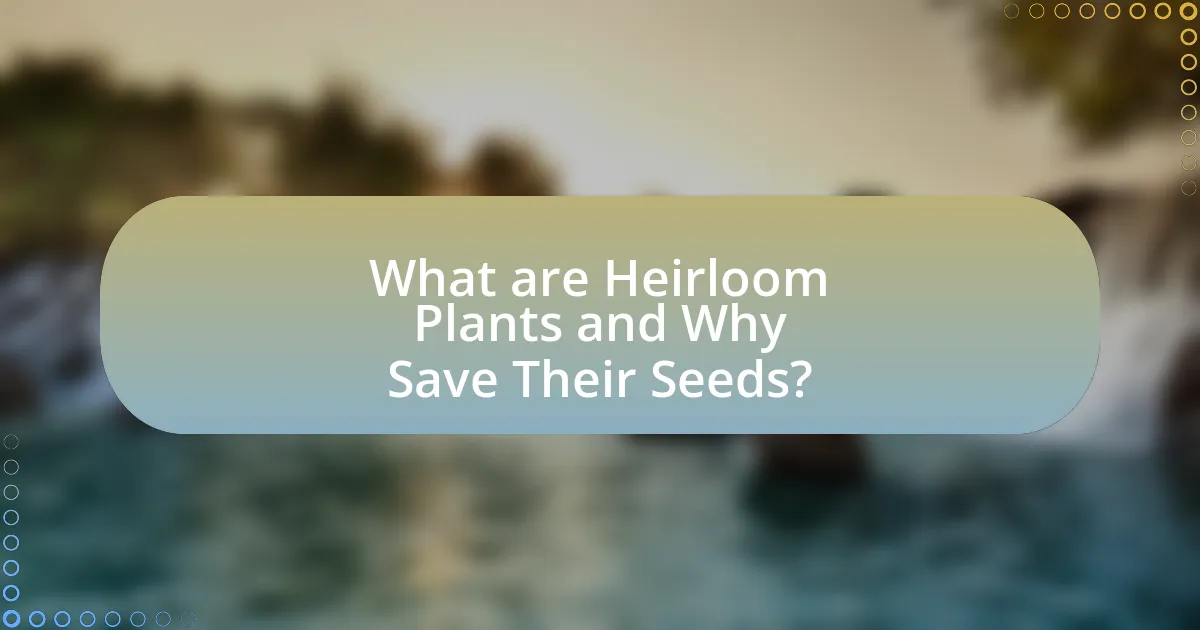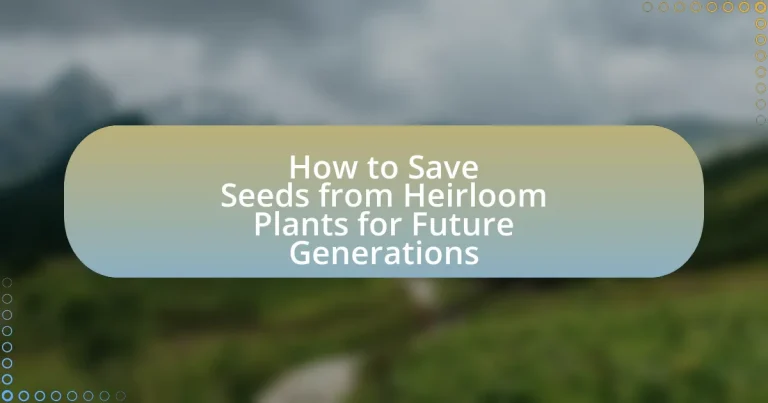Heirloom plants are traditional varieties that have been cultivated and passed down through generations, valued for their unique characteristics and flavors. This article outlines the importance of saving heirloom seeds to preserve genetic diversity, maintain traditional agricultural practices, and ensure the availability of these varieties for future generations. It details the differences between heirloom, hybrid, and GMO plants, the benefits of seed saving for biodiversity and sustainable gardening, and practical techniques for harvesting, drying, and storing seeds. Additionally, it addresses challenges in seed saving and offers resources for further learning, emphasizing the role of community seed exchanges in supporting these efforts.

What are Heirloom Plants and Why Save Their Seeds?
Heirloom plants are varieties of plants that have been passed down through generations, often for their unique characteristics and flavors. Saving their seeds is crucial because it preserves genetic diversity, maintains traditional agricultural practices, and ensures the availability of these unique varieties for future generations. Heirloom seeds are open-pollinated, meaning they can reproduce true to type, allowing gardeners to cultivate plants that are well-adapted to their local environments. This practice not only supports biodiversity but also fosters resilience in food systems, as diverse crops can better withstand pests and diseases.
How do heirloom plants differ from hybrid and GMO plants?
Heirloom plants differ from hybrid and GMO plants primarily in their genetic stability and breeding methods. Heirloom plants are open-pollinated varieties that have been cultivated and passed down through generations, maintaining their genetic traits over time, which allows for seed saving and consistent characteristics. In contrast, hybrid plants result from controlled crossbreeding between two different parent plants, leading to offspring that may not retain the same traits in subsequent generations, making seed saving unreliable. GMO plants, or genetically modified organisms, involve direct manipulation of an organism’s DNA in a laboratory setting to introduce specific traits, which can lead to unpredictable genetic outcomes and regulatory concerns. The distinction lies in heirloom plants’ traditional breeding practices and genetic consistency, compared to the variability of hybrids and the engineered nature of GMOs.
What characteristics define heirloom plants?
Heirloom plants are defined by their open-pollinated nature, which allows them to produce seeds that can be saved and replanted with the same characteristics as the parent plant. These plants typically have a long history of cultivation, often passed down through generations, and are valued for their unique flavors, colors, and resilience. Heirloom varieties are usually non-hybrid and non-GMO, ensuring genetic diversity and adaptability to local growing conditions. Historical records indicate that many heirloom plants have been cultivated for over 50 years, emphasizing their cultural significance and the importance of preserving them for future generations.
Why are heirloom plants important for biodiversity?
Heirloom plants are important for biodiversity because they preserve genetic diversity within crops, which is essential for ecosystem resilience and adaptability. These plants have been cultivated over generations, often in specific local environments, leading to unique traits that can enhance food security and agricultural sustainability. For instance, heirloom varieties can be more resistant to pests and diseases, reducing the need for chemical inputs. Additionally, they contribute to the preservation of cultural heritage and traditional agricultural practices, which are vital for maintaining diverse ecosystems. Studies have shown that maintaining a wide range of plant genetic resources can help mitigate the impacts of climate change on agriculture, ensuring that future generations have access to a variety of food sources.
What are the benefits of saving seeds from heirloom plants?
Saving seeds from heirloom plants offers several benefits, including preserving genetic diversity, ensuring plant adaptability, and maintaining unique flavors and characteristics. Heirloom seeds are open-pollinated, meaning they can be saved and replanted year after year, which promotes biodiversity and resilience in local ecosystems. Additionally, these seeds often carry historical significance and cultural heritage, allowing gardeners to connect with traditional agricultural practices. Studies show that heirloom varieties can outperform hybrids in taste and nutritional value, making them a valuable resource for sustainable gardening and food security.
How does saving seeds contribute to sustainable gardening?
Saving seeds contributes to sustainable gardening by promoting biodiversity and reducing dependency on commercial seed sources. When gardeners save seeds from heirloom plants, they preserve unique genetic traits that are well-adapted to local conditions, enhancing resilience against pests and diseases. This practice also minimizes the environmental impact associated with seed production and transportation, as it encourages the use of locally adapted varieties. According to the Seed Savers Exchange, maintaining diverse seed stocks can help ensure food security and ecological balance, as diverse crops are less susceptible to widespread failures.
What economic advantages does seed saving offer?
Seed saving offers significant economic advantages by reducing the costs associated with purchasing seeds each planting season. By saving seeds from heirloom plants, gardeners and farmers can ensure a continuous supply of crops without the recurring expense of buying new seeds, which can be particularly high for hybrid or commercially produced varieties. Additionally, seed saving promotes self-sufficiency and resilience against market fluctuations, as individuals are less reliant on external seed suppliers. According to a study by the University of California, seed saving can lead to a reduction in seed costs by up to 90%, demonstrating its potential for substantial economic savings.
What are the basic steps to save seeds from heirloom plants?
To save seeds from heirloom plants, follow these basic steps: first, select mature seeds from healthy plants at the end of the growing season. Next, collect the seeds by either cutting open the fruit or pod and extracting the seeds or by shaking the seeds from the plant. After collection, clean the seeds to remove any pulp or debris, ensuring they are dry and free from moisture. Finally, store the seeds in a cool, dark, and dry place in labeled containers to maintain their viability for future planting. These steps are essential for preserving the genetic diversity and characteristics of heirloom varieties.
How do you determine the right time to harvest seeds?
To determine the right time to harvest seeds, observe the maturity of the seed pods or fruits, which should be dry and brown, indicating that the seeds inside are fully developed. For example, many plants, such as tomatoes and peppers, show signs of ripeness when their color changes and they become firm. Additionally, seeds should be harvested before they fall to the ground to ensure they are collected at their peak viability. Research indicates that seeds harvested at the right time have a higher germination rate, which is crucial for successful planting in future generations.
What methods can be used to extract seeds from plants?
Methods to extract seeds from plants include manual harvesting, fermentation, and mechanical extraction. Manual harvesting involves collecting mature seed pods or fruits by hand, ensuring seeds are viable. Fermentation is used for fleshy fruits, where seeds are separated from the pulp through a process of rotting, which helps in seed cleaning. Mechanical extraction utilizes tools or machines to separate seeds from plant material efficiently. These methods are widely recognized in horticulture and agriculture for their effectiveness in seed extraction.

What Techniques are Used for Saving Seeds?
Techniques used for saving seeds include drying, fermentation, and proper storage. Drying involves removing moisture from seeds to prevent mold and decay, which is essential for long-term viability. Fermentation is a technique often used for fruits like tomatoes, where seeds are soaked in water to separate them from the pulp, enhancing germination rates. Proper storage requires keeping seeds in a cool, dark, and dry environment, often in airtight containers, to maintain their viability for several years. These methods are supported by agricultural practices that emphasize seed preservation for future planting.
How do you properly dry and store seeds?
To properly dry and store seeds, first, ensure that the seeds are fully mature and free from moisture. After harvesting, spread the seeds in a single layer on a clean, dry surface, such as a paper towel or a mesh screen, and allow them to air dry in a cool, dark place for about one to two weeks. Once dried, store the seeds in airtight containers, such as glass jars or sealed envelopes, and keep them in a cool, dark, and dry location to maintain their viability. Research indicates that seeds stored under these conditions can remain viable for several years, with some types lasting even longer when kept at lower temperatures.
What are the best practices for drying seeds to ensure viability?
The best practices for drying seeds to ensure viability include using a well-ventilated area, maintaining low humidity, and avoiding direct sunlight. Proper ventilation prevents mold and rot, while low humidity levels help to reduce moisture content, which is crucial for seed longevity. Avoiding direct sunlight protects seeds from heat damage, which can impair germination rates. Research indicates that seeds should be dried to a moisture content of around 5-7% for optimal storage, as seeds with higher moisture levels are more susceptible to decay and loss of viability.
How should seeds be stored to maximize their lifespan?
Seeds should be stored in a cool, dry, and dark environment to maximize their lifespan. This storage method helps to prevent moisture and light exposure, which can lead to seed deterioration. For optimal conditions, seeds should be kept in airtight containers, such as glass jars or vacuum-sealed bags, and placed in a refrigerator or a temperature-controlled space. Research indicates that seeds stored at temperatures around 32°F (0°C) and low humidity can remain viable for several years, with some seeds lasting over a decade when stored properly.
What are the specific techniques for different types of seeds?
Specific techniques for different types of seeds include drying, fermentation, and cold storage. For example, seeds from tomatoes and cucumbers benefit from fermentation, where seeds are soaked in water to remove the gelatinous coating, promoting better germination. In contrast, seeds from beans and peas should be dried thoroughly before storage to prevent mold and decay. Cold storage is effective for seeds like carrots and lettuce, which require a period of dormancy to germinate successfully. These methods are validated by horticultural practices that emphasize the importance of proper seed handling to ensure viability for future planting.
How do you save seeds from fruits versus vegetables?
To save seeds from fruits, extract the seeds, clean them of any fruit residue, and dry them thoroughly before storing in a cool, dark place. In contrast, saving seeds from vegetables typically involves allowing the vegetable to mature fully on the plant, then harvesting the seeds, cleaning them, and also drying them before storage. This method is essential because seeds from fruits often require fermentation to remove the gelatinous coating, while vegetable seeds may need to be dried directly after extraction to prevent mold.
What unique considerations are there for saving flower seeds?
Saving flower seeds requires specific considerations to ensure viability and genetic integrity. First, it is essential to select seeds from healthy, mature flowers, as immature seeds may not germinate effectively. Additionally, cross-pollination can occur among different varieties, leading to hybrid seeds; therefore, isolating flower varieties by distance or time can help maintain purity. Proper drying and storage conditions are crucial; seeds should be dried thoroughly to prevent mold and stored in a cool, dark, and dry environment to prolong shelf life. Furthermore, labeling seeds with the variety and date of collection aids in organization and future planting. These practices are supported by horticultural guidelines that emphasize the importance of seed quality and storage conditions for successful germination and plant growth.

What Challenges Might You Face When Saving Seeds?
When saving seeds, you may face challenges such as seed viability, genetic purity, and pest or disease contamination. Seed viability can diminish over time, leading to poor germination rates; for instance, some seeds lose viability within a year if not stored properly. Genetic purity is crucial, as cross-pollination can occur between different varieties, resulting in hybrid seeds that do not retain the desired traits of heirloom plants. Additionally, pests and diseases can affect the seeds during the saving process, potentially leading to infestations or infections that compromise the seeds’ health. These challenges necessitate careful planning and management to ensure successful seed saving.
What common mistakes should be avoided in seed saving?
Common mistakes to avoid in seed saving include saving seeds from hybrid plants, which do not produce true-to-type offspring, and neglecting to properly dry seeds, leading to mold and reduced viability. Additionally, failing to label seeds accurately can result in confusion during planting, while not considering cross-pollination can lead to unintended genetic variations. Proper storage conditions, such as maintaining low humidity and stable temperatures, are crucial; neglecting these can significantly decrease seed longevity.
How can contamination affect seed purity?
Contamination can significantly affect seed purity by introducing unwanted genetic material or pathogens, which can compromise the integrity of the seed stock. When seeds are contaminated, they may cross-pollinate with other varieties, leading to hybridization that alters the desired traits of heirloom plants. For instance, studies have shown that even minimal cross-contamination can result in a loss of specific characteristics, such as flavor or disease resistance, which are essential for maintaining heirloom varieties. Additionally, the presence of pathogens can lead to reduced germination rates and poor plant health, further diminishing the quality and viability of the seeds.
What are the signs of seed viability loss?
Signs of seed viability loss include reduced germination rates, abnormal seed appearance, and changes in seed moisture content. Specifically, seeds that exhibit a decline in germination rates often fail to sprout or take significantly longer to germinate compared to healthy seeds. Abnormal seed appearance may manifest as discoloration, shriveling, or the presence of mold, indicating deterioration. Additionally, seeds that have lost viability typically show changes in moisture content, often becoming excessively dry or overly moist, which can compromise their ability to germinate. These indicators are critical for assessing the health and potential future use of seeds, particularly in the context of preserving heirloom plant varieties.
How can you ensure the success of your seed saving efforts?
To ensure the success of your seed saving efforts, select healthy, mature plants for seed collection. This practice is crucial because seeds harvested from robust plants are more likely to produce strong offspring. Additionally, properly dry and store seeds in a cool, dark, and dry environment to maintain their viability. Research indicates that seeds stored under optimal conditions can remain viable for several years, with some heirloom varieties lasting even longer. Regularly test seed germination rates to assess their viability before planting, ensuring that your saved seeds will perform well in future growing seasons.
What resources are available for learning more about seed saving?
Books, online courses, and community workshops are valuable resources for learning about seed saving. Notable books include “Seed to Seed” by Suzanne Ashworth, which provides detailed instructions on saving seeds from various plants, and “The Seed Garden” by Lee Buttala and Shanyn Siegel, which offers insights into seed saving practices. Online platforms like the Seed Savers Exchange provide extensive resources, including articles and forums for seed savers. Additionally, local agricultural extension services often host workshops and provide educational materials on seed saving techniques, making them accessible to the community.
How can community seed exchanges support your seed saving journey?
Community seed exchanges can significantly enhance your seed saving journey by providing access to a diverse range of heirloom seeds and fostering a network of knowledge sharing among gardeners. These exchanges allow individuals to trade seeds, ensuring genetic diversity and resilience in crops, which is crucial for sustainable gardening practices. Research indicates that community seed banks and exchanges contribute to preserving local biodiversity, as they often focus on regional varieties that are well-adapted to local conditions. Additionally, participating in these exchanges facilitates the sharing of best practices and techniques for seed saving, which can improve your skills and success in preserving heirloom plants for future generations.
What are some practical tips for successful seed saving?
Successful seed saving involves selecting healthy, mature seeds from heirloom plants, ensuring they are properly dried and stored in a cool, dark place. To achieve this, gardeners should choose seeds from the best plants, as these are more likely to produce strong offspring. Additionally, it is crucial to allow seeds to fully mature on the plant before harvesting, as immature seeds may not germinate effectively. After harvesting, seeds should be cleaned and dried thoroughly to prevent mold and decay. Finally, storing seeds in airtight containers with labels indicating the plant variety and date of harvest helps maintain their viability over time.





